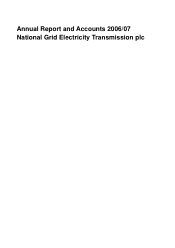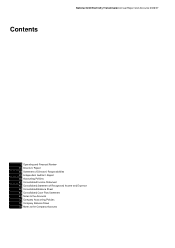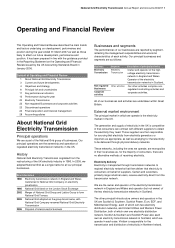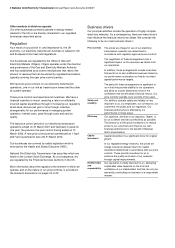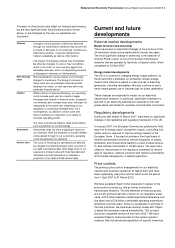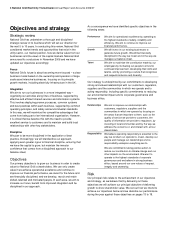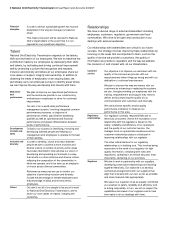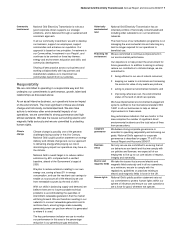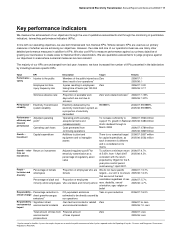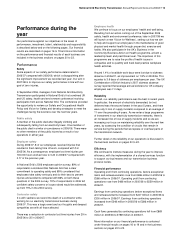National Grid 2007 Annual Report Download - page 5
Download and view the complete annual report
Please find page 5 of the 2007 National Grid annual report below. You can navigate through the pages in the report by either clicking on the pages listed below, or by using the keyword search tool below to find specific information within the annual report.
National Grid Electricity Transmission Annual Report and Accounts 2006/07 3
A number of other factors also affect our financial performance,
but are less significant than the principal business drivers
above, or are mitigated by the way our operations are
structured:
Volumes Changes in the quantities of electricity delivered
through our transmission networks may result in an
increase or decrease in our revenues. Volumes are
affected by weather, consumer demand and
network availability as well as other factors.
The impact of changing volumes may sometimes
be offset by changes in costs or may sometimes
result in an under- or over-recovery against our
allowable revenues, with a corresponding increase
or decrease in revenues in future periods.
Pass-through
costs
We are allowed to recover certain costs through
charges to customers. The timing of recovery of
these costs can vary between financial periods
leading to an under- or over-recovery within any
particular financial period.
Inflation Without action to improve efficiency, our operating
costs increase each year as a result of wage
increases and inflation in external costs. In general,
our revenues also increase each year, although not
necessarily at the same rate, depending on our
regulatory or contractual arrangements. As a
consequence, our ability to control costs and
improve efficiency is important to our ability to
increase operating profits.
Our price controls are linked to retail price inflation,
as is a proportion of our borrowings.
Seasonality Seasonality does not have a significant impact on
our revenues. With the exception of volume related
costs passed through to our customers, operating
costs are generally not seasonal.
Interest rates The costs of financing our operations are affected
by changes in prevailing interest rates, as some of
our debt is at floating rates. We hedge some of our
exposure to interest rates with fixed rate debt and
derivative financial instruments to maintain a
proportion of our debt at fixed interest rates.
Current and future
developments
External market developments
Market structure and ownership
There have been no significant changes in the structure of the
UK electricity infrastructure market within the last two years.
The most significant change in ownership is the takeover of
Scottish Power (owner of one of the Scottish transmission
networks that we operate) by Iberdrola, a Spanish utility, which
completed on 23 April 2007.
Energy market developments
The UK is in a period of changing energy supply patterns, as
the Government’s emphasis on combating climate change
means more reliance is placed on new sources of electricity
generation, including renewables. We also continue to see a
trend toward greater use of imported gas for power generation.
These changes are expected to impact on our electricity
transmission networks. In particular, significant investment is
planned in our electricity transmission networks to link new
power plants with domestic, business and industrial consumers.
Regulatory developments
During the year ended 31 March 2007, there were no significant
changes in the legislative and regulatory framework in the UK.
In January 2007, the European Commission published its final
report on its energy sector competition inquiry, concluding that
further action is required to improve energy markets in the
European Union. It focused on problems from high levels of
market concentration as well as vertical integration of supply,
generation and infrastructure leading to a lack of equal access
to, and sufficient investment in, infrastructure. The report also
called for improvement in the regulatory framework to remove
gaps in regulation, address concerns with market concentration
and increase transparency in market operations.
Price controls
The previous price control arrangements for our electricity
transmission business ceased on 31 March 2007 and have
been replaced by new price controls which cover the period
from 1 April 2007 to 31 March 2012.
We have accepted Ofgem’s final proposals in respect of the
price control covering our role as owner of electricity
transmission networks. The key elements of these proposals
are a 4.4% post-tax real rate of return on our regulatory asset
value, a £3.5 billion baseline capital expenditure allowance over
five years and a £0.9 billion controllable operating expenditure
allowance over five years. Since our acceptance in principle of
the final proposals, we have been working closely with Ofgem
to agree the necessary licence amendments. This process
should be completed during the first half of 2007. We have
accepted Ofgem's final proposals for the system operator
schemes that include annual negotiation on specific incentives.

